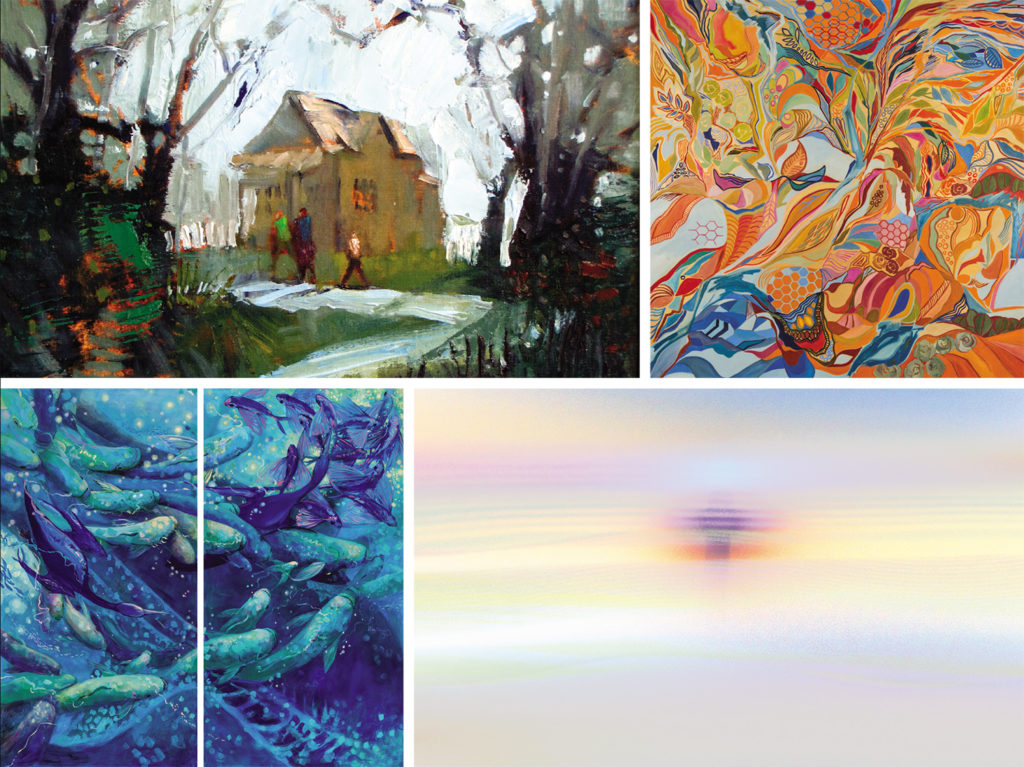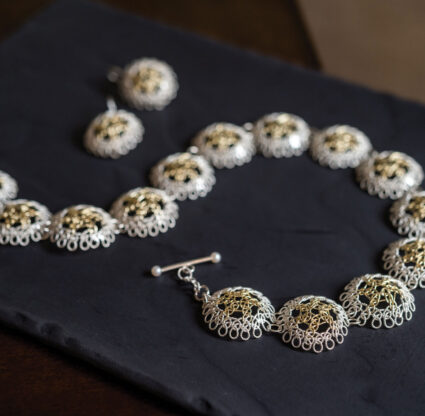Mally Khorasantchi
Driving home from her studio, Mally Khorasantchi often imagines painting the white stripes in the middle of the road in the luscious colors she’s left behind on her palette. Known for the spirited range of hues in her abstract paintings—from soft dove grays and watery blues to brilliant red, hot pink and tangerine tones—Khorasantchi is nothing if not emotionally expressive in her color choices. “As soon as I start to paint, I’m totally connected to color,” she says. “I love to express myself through it, and it makes me absolutely joyous.”
At the heart of her work is an attraction to the mysterious forces of the natural world in Southwest Florida, particularly in the mangrove forests along the coast. “The mangroves are a magic forest to me. There’s something spiritual in there—along with the mud and snakes and crawly things,” she adds with a quick smile. She believes the plants are an emblem of the dynamic pattern of life, with their constant cycle of decay balanced by the simultaneous upwelling of fresh sprouts.
Her recent work, such as the large mixed-media The Hidden Secrets of Trees #1, presents a rich and chaotic vision of the world as a place in constant flux. Waves of form and color wash over the viewer, carrying both strong feelings and near-silent whispers of information contained in intricate bits of paper cut from magazines and other printed matter that are collaged amid the painted forms.
Khorasantchi’s newest paintings will be on view at Florida Gulf Coast University’s ArtLab Gallery from Feb. 21 to March 28, 2019, with an opening reception and artist’s talk from 5-7 p.m. on Feb. 21. mallykhorasantchi.com
Lynda Fay Braun
Lynda Fay Braun calls her recent photographic works “digital paintings.” The luminous images in her series Ebb and Flow begin with a digital photograph of light reflected on a metallic surface. Then, she imports the picture into her image-processing program, often working on-screen for hours at a time and creating several versions of the image before she prints one on the antique lithography paper she received as a gift from the estate of Naples abstract painter Tom Burke. “I want to see what I can draw out of the image,” she explains. “I’m looking for something that speaks to me. I bring my whole painting background to the computer.” Once a piece is printed, she likes to go in with pastel pencils to subtly enhance parts of the image by hand.
The pictures in this series are powerfully serene, their quietude informed by Braun’s years of meditation practice. Horizontal bands of color stretch and waver, sometimes in candy shades reminiscent of dawn or sunset along the beach, as in Far on the Wind or New Light. Viewers often perceive landscapes, lapping water and limitless horizons in her elegantly ambiguous images. And they are not wrong. A sense of the natural beauty in Southwest Florida has undoubtedly seeped into her art. Braun says, “I look at my work over the past 20 years and I see how very entwined it is with this subtropic climate, its watery ways and its golden light. Though I’ve been fighting it at times, I’m deeply connected to this place.” lyndafaybraun.com
Megan Kissinger
“All of my paintings have a story to tell,” muses Fort Myers-based Megan Kissinger, “and all of my paintings start with line, whether it’s the lines of trees, roots or grasses.” With a concentrated dose of wildlife art in her background, Kissinger is ever alert to the nuances of habitat and animal behavior in her work, too. Paintings such as her recent large-scale canvas, The Dude Ranch Above the Sea—Telegraph Creek in Summer, are precise, passionate and ecologically aware.
Dude Ranch memorializes a spot in the Babcock Ranch preserve that straddles Lee and Charlotte counties. It is “a tract of land that is about as wild as you can get in Florida,” Kissinger writes, part of the vast Everglades watershed. “My husband and I kayak the creek, and this particular painting marks the spot where you cannot kayak any further. In the dry season, the creek bed dries down to a trickle, and we sometimes brave the alligators, tie up our boats and hike up the creek.” Part of the reason she depicts such places is because she knows how fragile they are, and susceptible to development.
In addition to the big picture of Florida’s complex ecosystems, Kissinger attends to the tiny things in nature. On a grand scale, the Everglades landscape is hot, buggy and flat. It’s not necessarily a place that immediately appeals to many people. But the trick, she says, is to slow down and observe the small wonders of lichens, lizards, cypress knobs and reflections in the tea-colored water, perhaps while keeping an eye out for the occasional bird sailing past. “You see that everything is connected,” she adds.
A conservator at the Edison & Ford Winter Estates in Fort Myers, Kissinger teaches botanical drawing classes in the gardens there in January, February and March. Her work is carried by Tower Gallery on Sanibel, WildChild Art Gallery in Matlacha and in the Edison Ford museum stores. megankissinger.com
Peter Zell
“I believe that paint must be applied liberally, and the hand of the artist should be apparent in the painting,” notes Peter Zell. Retired from a law career in Southern California, he began to paint in earnest upon moving to Sanibel Island in 2005. He paints outdoors as much as possible, usually in oils. His modestly scaled scenes beautifully capture the light and air of coastal Florida. Well-worn motifs—beach cottages, the iconic Sanibel lighthouse and roadside fish shacks—are translated into solid, satisfying images.
His paint handling is inspired both by the masters of Postimpressionism and by more contemporary artists; for instance, modernist painter Richard Diebenkorn, whose influence can be felt in Zell’s broad patches of color and the geometric scaffolding of his compositions. “I want people to know that they are not looking at a realist painting, although I want them to know generally what they are looking at,” Zell explains. “So, I try to abstract the image by line, form, value and color—exaggerating or altering these traditional things and adding movement and patterns.”
Zell is a member of Hirdie Girdie Gallery on Sanibel, where he normally exhibits November through April. His work is also carried by Two Islands Gallery located on Captiva. He’s a member of the Florida Artists Group, whose regional membership show will be presented at the Naples Art Association in March 2019. peterzellartist.com
Janice T. Paine is the education program manager at the United Arts Council of Collier County, and a frequent writer about contemporary and historic art.





